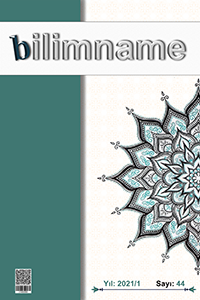Abstract
تعد دراسة تاريخ الخطوط العربية في مركز الجزيرة العربية ومحيطها حسب الحقب التاريخية؛ الخطوة الأولى لدراسة الخط العربي الذي كُتِبَ به المصحف الشريف في الحجاز (مكة المكرمة، والمدينة المنورة)، وهذا يسوقنا إلى دراسة تاريخ كتابة المصحف الشريف في صدر الإسلام، حيث أن كتابة المصحف شهدت مرحلتين مختلفتين في حياة النبي (عليه السلام)؛ مرحلة الكتابة المكيَّة، والمرحلة المدنية، ثم تبعها مرحلة الجمع والنسخ زمن الخلفاء الراشدين. ففي مرحلة التنزيل خَصَّصَ النبي (عليه السلام) أَمْهرَ الصحابة بالقراءة والكتابة لكتابة القرآن، وقارب عددهم الخمسين تقريباً. وبالرغم من أن مكة (المكرمة) والمدينة (المنورة) شهدتا نزول الوحي؛ إلا أن لكل منهما خصوصية في رسم الحرف العربي الذي كتب به المصحف الشريف في الرقوق والرقاع تزامنا مع التنزيل، وفي هذه الدراسة سيسلط الضوء على سمات المدرسة المكية والمدنية في رسم المصحف الشريف، وانعكاس هذه القواعد المُؤسِّسَة للكتابة على شكل المصاحف فيما بعد، في القرن الهجري الأول؛ ففي هذا العصر ظهر تطور صنعة الخط والحرف العربي بأعلى مستوى بما يتناسب وجمالية صيانة المصحف الشريف، فكما اهتم العلماء بحفظه؛ اهتم النُّساخ والكُتَّابُ بكتابته المصحف بخطوط منسجمة مع قواعد الكتابة الأولى للمصحف الشريف، فاشنهرت الخطوط المكية والمدنية في كل الجزيرة العربية لمركزيتهما الدينية والثقافية، وتزامن مع هذه الكتابة؛ كتابة المصحف بخطوط وأقلام مختلفة، لم تخرج عن تقاليد الكتابة الأولى؛ كالمشق الأموي والكوفي المصحفي وغيره من الخطوط المصحفية، واستمرت الكتابة بانسجامها والمصحف الإمام؛ بما يحفظ النَّص الأول في شكله ولفظه وأدائه عبر التاريخ إلى يومنا الحاضر.
References
- Referans1: البَطَلْيَوسي، أبو محمد عبد الله بن محمد بن السِّيد. الاقتضاب في شرح أدب الكتاب. تح. مصطفى السقا وحامد عبد المجيد. القاهرة: دار الكتب المصرية، 1996م.
- Referans2: ابن الجوزي، أبو الفرج عبد الرحمن. المنتظم في تاريخ الأمم والملوك. تح. محمد عطا، مصطفى عطا. بيروت: دار الكتب العلمية، ط1، 1992م.
- Referans3: ابن حميد، صالح بن عبد الله. نضرة النعيم في مكارم أخلاق الرسول الكريم.، جدة: دار الوسيلة، ط4، د.ت.
- Referans4: ابن خلدون، عبد الرحمن بن محمد. ديوان المبتدأ والخبر في تاريخ العرب والبربر ومن عاصرهم من ذوي الشأن الأكبر. تح. خليل شحادة. بيروت: دار الفكر، ط2، 1988م.
- Referans5: İbnü'n Nedîm, Ebü’l-Ferec Muḥammed b. Ebî Ya‘kūb İsḥâk b. Muḥammed b. İsḥâk. el-Fihrist, İstanbul: Süleymaniye Kütüphanesi, Fażıl Aḥmed Paşa, 1134.
- Referans6: İbnü'n Nedîm, Ebü’l-Ferec Muḥammed b. Ebî Ya‘kūb İsḥâk b. Muḥammed b. İsḥâk. el-Fihrist, İstanbul: Süleymaniye Kütüphanesi, Fażıl Aḥmed Paşa, 1135.
Abstract
Keywords
The Mushaf the Mecca handwriting the writer of Revelation the Medina handwriting İbnu’n-Nedîm
References
- Referans1: البَطَلْيَوسي، أبو محمد عبد الله بن محمد بن السِّيد. الاقتضاب في شرح أدب الكتاب. تح. مصطفى السقا وحامد عبد المجيد. القاهرة: دار الكتب المصرية، 1996م.
- Referans2: ابن الجوزي، أبو الفرج عبد الرحمن. المنتظم في تاريخ الأمم والملوك. تح. محمد عطا، مصطفى عطا. بيروت: دار الكتب العلمية، ط1، 1992م.
- Referans3: ابن حميد، صالح بن عبد الله. نضرة النعيم في مكارم أخلاق الرسول الكريم.، جدة: دار الوسيلة، ط4، د.ت.
- Referans4: ابن خلدون، عبد الرحمن بن محمد. ديوان المبتدأ والخبر في تاريخ العرب والبربر ومن عاصرهم من ذوي الشأن الأكبر. تح. خليل شحادة. بيروت: دار الفكر، ط2، 1988م.
- Referans5: İbnü'n Nedîm, Ebü’l-Ferec Muḥammed b. Ebî Ya‘kūb İsḥâk b. Muḥammed b. İsḥâk. el-Fihrist, İstanbul: Süleymaniye Kütüphanesi, Fażıl Aḥmed Paşa, 1134.
- Referans6: İbnü'n Nedîm, Ebü’l-Ferec Muḥammed b. Ebî Ya‘kūb İsḥâk b. Muḥammed b. İsḥâk. el-Fihrist, İstanbul: Süleymaniye Kütüphanesi, Fażıl Aḥmed Paşa, 1135.
Abstract
References
- Referans1: البَطَلْيَوسي، أبو محمد عبد الله بن محمد بن السِّيد. الاقتضاب في شرح أدب الكتاب. تح. مصطفى السقا وحامد عبد المجيد. القاهرة: دار الكتب المصرية، 1996م.
- Referans2: ابن الجوزي، أبو الفرج عبد الرحمن. المنتظم في تاريخ الأمم والملوك. تح. محمد عطا، مصطفى عطا. بيروت: دار الكتب العلمية، ط1، 1992م.
- Referans3: ابن حميد، صالح بن عبد الله. نضرة النعيم في مكارم أخلاق الرسول الكريم.، جدة: دار الوسيلة، ط4، د.ت.
- Referans4: ابن خلدون، عبد الرحمن بن محمد. ديوان المبتدأ والخبر في تاريخ العرب والبربر ومن عاصرهم من ذوي الشأن الأكبر. تح. خليل شحادة. بيروت: دار الفكر، ط2، 1988م.
- Referans5: İbnü'n Nedîm, Ebü’l-Ferec Muḥammed b. Ebî Ya‘kūb İsḥâk b. Muḥammed b. İsḥâk. el-Fihrist, İstanbul: Süleymaniye Kütüphanesi, Fażıl Aḥmed Paşa, 1134.
- Referans6: İbnü'n Nedîm, Ebü’l-Ferec Muḥammed b. Ebî Ya‘kūb İsḥâk b. Muḥammed b. İsḥâk. el-Fihrist, İstanbul: Süleymaniye Kütüphanesi, Fażıl Aḥmed Paşa, 1135.
Details
| Primary Language | Arabic |
|---|---|
| Journal Section | Articles |
| Authors | |
| Publication Date | April 30, 2021 |
| Submission Date | January 10, 2021 |
| Acceptance Date | March 3, 2021 |
| Published in Issue | Year 2021 Volume: 2021 Issue: 44 |

